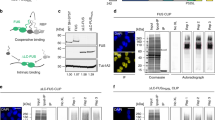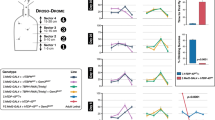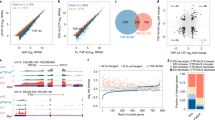Abstract
A subset of familial and sporadic amyotrophic lateral sclerosis (ALS — a fatal disorder characterised by progressive motor neuron degeneration) cases are due to mutations in the gene encoding Cu,Zn superoxide dismutase (SOD1)1–4. Two mutations which have been successfully used to generate transgenic mice that develop an ALS-like syndrome are glycine 85 to arginine (G85R) and glycine 93 to alanine (G93A) with the mutant SOD7 allele overexpressed in a normal mouse genetic background5–7. No ALS-like phenotype is observed in mice overexpressing wild-type SOD1 or mice without any SOD1 activity6,8,9. These dominant mutations, which do not necessarily decrease SOD1 activity, may confer a gain of function that is selectively lethal to motor neurons5,10–12. The yeast interaction trap system⊃13 allowed us to determine whether these mutations in SOD7 caused novel protein interactions not observed with wild-type SOD7 and which might participate in the generation of the ALS phenotype. Two proteins, lysyl-tRNA synthetase and translocon-associated protein delta, interact with mutant forms of SOD1 but not with wild-type SOD1. The specificity of the interactions was confirmed by the coimmunoprecipitation of mutant SOD1 and the expressed proteins. These proteins are expressed in ventral cord, lending support to the relevance of this interaction to motor neuron disease.
This is a preview of subscription content, access via your institution
Access options
Subscribe to this journal
Receive 12 print issues and online access
$209.00 per year
only $17.42 per issue
Buy this article
- Purchase on Springer Link
- Instant access to full article PDF
Prices may be subject to local taxes which are calculated during checkout
Similar content being viewed by others
References
Rosen, D.R. et al. Mutations in Cu/Zn superoxide dismutase gene are associated with familial amyotrophic lateral sclerosis. Nature 362, 59–62 (1993).
Pramatarova, A. et al. Identification of new mutations in the Cu/Zn superoxide dismutase gene of patients with familial amyotrophic lateral sclerosis. Am. J. Hum. Genet. 56, 592–596 (1995).
Jones, C.T., Brock, D.J.H., Chancellor, A.M., Warlow, C.P. & Swingler, R.J. Cu/Zn superoxide dismutase (SOD1) mutations and sporadic amyotrophic lateral sclerosis. Lancet 342, 1050–1051 (1993).
Swingler, R.J., Jones, C. & Brock, D.J.H. Superoxide dismutase and amyotrophic lateral sclerosis. Lancet 345, 391 (1995).
Gurney, M.E. et al. Motor neuron degeneration in mice that express a human Cu,Zn superoxide dismutase mutation. Science 264, 1772–1775 (1994).
Dal Canto, M.C. & Gurney, M.E. Development of central nervous system pathology in a murine transgenic model of human amyotrophic lateral sclerosis. Am. J. Pathol. 146, 1271–1279 (1994).
Ripps, M.E., Huntley, G.W., Hof, P.R., Morrison, J.H. & Gordon, J.W. Transgenic mice expressing an altered murine superoxide dismutase gene provide an animal model of amyotrophic lateral sclerosis. Proc. Natl. Acad. Sci. USA 92, 689–693 (1995).
Chan, P.H., Chu, L., Chen, S.F., Carlson, E.J. & Epstein, C.J. Reduced neurotoxicity in transgenic mice overexpressing human copper-zinc-superoxide dismutase. Stroke 21, 111(80)–111(82) (1990).
Reaume, A.G. et al. Motor neurons in Cu/Zn superoxide dismutase-deficient mice develop normally but exhibit enhanced cell death after axonal injury. Nature Genet. 13, 43–47 (1996).
Fujii, J. et al. Characterization of wild-type and amyotrophic lateral sclerosis-related mutant Cu,Zn-superoxide dismutases overproduced in Baculovirus-infected insect cells. J. Neurochem. 64, 1456–1461 (1995).
Tsuda, T. et al. Analysis of the functional effects of a mutation in SOD1 associated with familial amyotrophic lateral sclerosis. Neuron 13, 727–736 (1994).
Borchelt, D.R. et al. Superoxide dismutase 1 subunits with mutations linked to familial amyotrophic lateral sclerosis do not affect wild-type subunit function. J. Biol. Chem. 270, 3234–3238 (1995).
Finley, R.L. Jr & Brent, R. Interaction trap cloning with yeast. in Gene Probes —A practical approach (Oxford University Press, 1984).
Rabizadeh, S. et al. Mutations associated with amyotrophic lateral sclerosis convert superoxide dismutase from an antiapoptotic gene to a proapoptotic gene: studies in yeast and neural cells. Proc. Natl. Acad. Sci. USA 92, 3024–3028 (1995).
Hallewell, R.A. et al. Genetically engineered polymers of human CuZn superoxide dismutase: biochemistry and serum half-lives. J. Biol. Chem. 264, 5260–5268 (1989).
Hartmann, E. et al. A tetrameric complex of membrane proteins in the endoplasmic reticulum. Eur. J. Biochem. 214, 375–381 (1993).
Targoff, I.N., Trieu, E.P. & Miller, F.W. Reaction of Anti-OJ autoantibodies with components of the multi-enzyme complex of aminoacyl-tRNA synthetases in addition to isoleucyl-tRNA synthetase. J. Clin. Invest. 91, 2556–2564 (1993).
Gelpi, C., Martinez, M.A., Vidal, S., Targoff, I.N. & Rodriguez-Sanchez, J.L. Autoantibodies to a transfer RNA-associated protein in a murine model of chronic graft versus host disease. J. Immunol. 152, 1989–1999 (1994).
Gelin, C. et al. The E2 antigen, a 32 kd glycoprotein involved in T-cell adhesion processes, in the MIC2 gene product. EMBO J. 8, 3253–3259 (1989).
Online Mendelian Inheritance in Man, OMIM (TM). Center for Medical Genetics, Johns Hopkins University (Baltimore, MD) and National Center for Biotechnology Information, National Library of Medicine (Bethesda, MD), 1996. World Wide Web URL: http://www3.ncbi.nlm.nih.gov/omim/
Freist, W. & Gauss, D.H. Lysyl-tRNA synthetase. Biol. Chem. Hoppe-Seyler 376, 451–472 (1995).
Pardo, C.A. et al. Superoxide dismutase is an abundant component in cell bodies, dendrites, and axons of motor neurons and in a subset of other neurons. Proc. Natl. Acad. Sci. USA 92, 954–958 (1995).
Rosen, D.R. et al. A frequent ala 4 to val superoxide dismutase-1 mutation is associated with a rapidly progressive familial amyotrophic lateral sclerosis. Hum. Mol. Genet. 3, 981–987 (1994).
Holthuis, J.C.M., van Riel, M.C.H.M. & Martens, G.J.M. Translocon-associated protein TRAP5 and a novel TRAP-like protein are coordinately expressed with pro-opiomelanocortin in Xenopus intermediate pituitary. Biochem. J. 312, 205–213 (1995).
Wiedau-Pazos, M. et al. Altered reactivity of superoxide dismutase in familial amyotrophic lateral sclerosis. Science 271, 515–518 (1996).
Beckman, J., Carson, M., Smith, C.D. & Koppenol, W.H. ALS, SOD and peroxynitrite. Nature 364, 584 (1993).
Yim, M.B. et al. A gain-of function of an amyotrophic lateral sclerosis-associated Cu,Zn-superoxide dismutase mutant: An enhancement of free radical formation due to a decrease in Km for hydrogen peroxide. Proc. Natl. Acad. Sci. USA 93, 5709–5714 (1996).
Mourelatos, Z., Gonatas, N.K., Stieber, A., Gurney, M.E. & Dal Canto, M.C., Golgi apparatus of spinal cord motor neurons in transgenic mice expressing mutant Cu,Zn superoxide dismutase becomes fragmented in early, preclinical stages of the disease. Proc Natl. Acad. Sci. USA 93, 5472–5477 (1996).
Li, X.-J. et al. A huntingtin-associated protein enriched in brain with implications for pathology. Nature 378, 398–402 (1995).
Burke, J.R. et al. Huntingtin and DRPLA proteins selectively interact with the enzyme GAPDH. Nature Med. 2, 347–350 (1996).
Sikorski, R.S. & Hieter, P. A system of shuttle vectors and yeast host strains designed for efficient manipulation of DNA in Saccharomyces cerevisiae. Genetics 122, 19–27 (1989).
Bermingham-McDonogh, O., Gralla, E.B. & Selverstone Valentine, J. The copper, zinc-superoxide dismutase gene of Saccharomyces cerevisiae: cloning, sequencing, and biological activity. Proc. Natl. Acad. Sci. USA 85, 4789–4793 (1988).
Author information
Authors and Affiliations
Rights and permissions
About this article
Cite this article
Kunst, C., Mezey, E., Brownstein, M. et al. Mutations in SOD1 associated with amyotrophic lateral sclerosis cause novel protein interactions. Nat Genet 15, 91–94 (1997). https://doi.org/10.1038/ng0197-91
Received:
Accepted:
Issue Date:
DOI: https://doi.org/10.1038/ng0197-91
This article is cited by
-
Anti-apoptotic Splicing Variant of AIMP2 Recover Mutant SOD1-Induced Neuronal Cell Death
Molecular Neurobiology (2023)
-
Aminoacyl-tRNA synthetases as therapeutic targets
Nature Reviews Drug Discovery (2019)
-
Comparative interactomics analysis of different ALS-associated proteins identifies converging molecular pathways
Acta Neuropathologica (2016)
-
Expression profile of aminoacyl-tRNA synthetases in dorsal root ganglion neurons after peripheral nerve injury
Journal of Molecular Histology (2015)
-
The potential of GPNMB as novel neuroprotective factor in amyotrophic lateral sclerosis
Scientific Reports (2012)



